The vast yellow grassland has an eerie yet endearing sense about it. It lets you look out blankly into nothingness for as long as you please with *no conditions apply. The eye wanders for a while till it fixes its gaze upon something peculiar, something that moves, something that feeds or something that is looking back at one. The gaze is weighed down by the contours of the hump, the grizzliness of the mane or possibly at the agility of the gait and one is transfixed as time loses relevance. Such is the magnificence of nature, that which is beyond our control.
As a keen student, the geography textbook always fascinated me. I would flip through the pages to look at places that hadn’t been even covered by the teacher yet. It wasn’t a subject to me, it was like a fantasy. I would look at the illustrations and wonder what it would be like to be in this place or that. And of all the places, Africa had a different allure altogether. The sheer expanse of the continent, its diverse and unique landscape, the turbulent history of its people, everything about it made it almost enigmatic. It seemed so far away and growing up I always felt a strange beckoning to this dark continent. Of course, it is so vast, it would take anyone a lifetime to touch every last corner and I wouldn’t even commit myself to such a lofty resolution but the Eastern horn of Africa as it is called has a special place in the world of natural history and what could be a better start to my journey of Africa than that. The idea began taking shape sometime in 2015 when a colleague went away to Tanzania with his family. Upon his return he couldn’t stop describing the plethora of wildlife they witnessed over three days and at such close quarters. His stories brought to life the visions I had carried from my textbooks and all the Discovery films I had seen over the years. A little later another good friend mentioned it and I started imagining my African Safari already. I pitched the idea to a few like minded people to see if they would be interested. Soon enough, I had gotten two other friends and Sonam on board. We knew what we wanted to see but which reserve was to be visited was the question. August is that time of the year around which I plan my week-long annual holiday and hence, the natural choice was Masai Mara. The great migration arrives in Mara by August and the lions are spoilt for choice. There is plenty of game in the park and the big cats are out hunting. There couldn’t really be a better time to be in Kenya- the safari capital of Africa.
Kenya is a country located right on the equator but the Mara reserve which runs along the south western flank of the country falls in the southern hemisphere. Nairobi, the capital city and the first stop for all international tourists also lies a little south of the equator and hence, the weather in August is mildly cold which is surprising for most first timers. The overall topography of the country renders it cooler than most tropical destinations. The Kenyan government, in a bid to boost tourism has introduced e-visa for most countries making the process, literally, a cake walk. You sign up on the website, submit a copy of your passport, fill out your details and pay up USD 50. All in an hour’s work and if there is nothing wrong with your application you can get your visa in a day or less. Mine arrived the day after and I knew we were off to a good start.

Flights from India are not abundant but there are a few good options like Jet-Etihad which if purchased well in time can get you a good deal. We bought ours 5 months in advance for less than USD 500 each. The flight was comfortable with average leg space and palatable food. Abu Dhabi airport which was our transit was less than impressive but then again my reference is Dubai or New Delhi which isn’t really fair. It was crowded and felt cramped. Anyhow, the transit was about 2 hr and hence manageable. We arrived in Nairobi a little past 1 p.m. at a not so remarkable international terminal but the immigration process was crisp and in spite of the long queue we were through in less than an hour. There is a bureau de Exchange counter inside the terminal which gives you a good rate unlike some other airports I have been. 1 USD to 100 shilling was the going market rate then and the counter gave us 99 if I remember correctly. You will see a Safaricom kiosk as you move out into the lobby where you can purchase a prepaid SIM for voice or data or both without any hassle by just producing your travel document. We bought one for 2000 KSH which gave us more than enough voice and data than we needed for the week. There are other operators too but Safaricom has best countrywide connectivity and offers good rates. The average Indian will find voice calling in Kenya 3 times more expensive than home and I think the locals feel the pinch too as many prefer calling over internet to save costs. But the ease of procuring a SIM in any part of the world as opposed to India makes me pretty sad. Anyhow, with the SIM in my phone, we were on our way to the apartment we had rented near Strathmore university halfway between the international airport and the city centre. Here, I feel I need to mention that my experience with booking a place through Airbnb in Kenya wasn’t as smooth as it usually is. Two of my prior bookings were cancelled by the hosts days before the actual travel for some hard to believe reasons. But our stay at Kipngeno’s apartment was problem free and since we were spending just a night in Nairobi, it didn’t really matter as much. Later that night we called a cab to go downtown using Uber and that worked just fine too. Surprisingly, the native Kenyans in general and Nairobians in particular speak remarkably good English and communication can be a breeze for foreigners. Our cabbie was friendly and helped us narrow down our search for a good pub pretty quickly to Havana Bar. This dimly lit pub has a friendly vibe and from what we could see is popular with expats and tourists. The staff at the bar was helpful and amiable. The girl waiting our table was rather confused at our strange request for hot water with our whiskey. She had to ask us twice if we wanted hot or room temperature. The music was loud and we didn’t try explaining about our soar throats and running noses. The food was above average and the liquor cheap (by New Delhi standards). We enjoyed observing the locals, sampling the kinky urban art on the walls and the warm whiskey going down our throats made the chilly Nairobi night as pleasant as it could get. Happy high we went out of the bar, tipping our waitress more generously than we would back home.
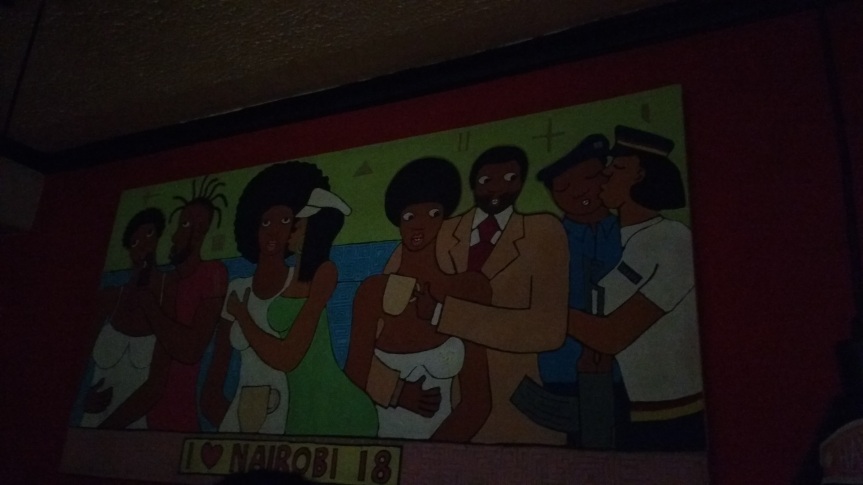
One peculiarity I couldn’t help but notice in Nairobi was that the navigation display unit in all the cars we sat in was in Chinese or Japanese or one of those languages from the Far East that I cannot read. The make of the car didn’t matter really and when I asked one of the drivers about it he said he had noticed it too but had no clue why. I assumed that possibly, they depend heavily on importing CBUs in Kenya. My assumption was further strengthened when I saw the price of a mid size car advertised on a hoarding outside a dealership in the town. This car was easily more than twice as expensive than home where the car market is predominantly local manufacturing.
Next morning we were picked up by Ambrose, our driver and guide for the next 3 days. Ambrose wasn’t particularly happy with us since we were late for the pickup. A day long flight and last night’s whiskey had their effect and we took longer than anticipated to pack up and leave. Before leaving town, we went into the city centre once again to make the final payment at the safari operator’s office and picked up some much needed breakfast from the local favorite- Java Coffee house. The breakfast was simple but filling. Banana cake, boiled veggies, sandwich and fries. The coffee was above average without doubt. A really good brew made from the world famous Kenyan beans and yet somehow they choose to call themselves Java House. Irony.
Nearly after two hours on the road we were treated to our very first view of the rift valley. I could hardly contain my childlike eagerness to get a closer look and began to bug Ambrose to pull over.He stopped a little further at some kind of a tourist point where there were several other vans like ours. There was also a curio shop and a snack bar. The view from here was fantastic to say the least. As far as you ran your sight you could see the unending flatness of the depression below. For miles together, the African bush just lay there, undisturbed, uninhabited and perfectly wild. A closer inspection with our binoculars threw up a TV station deep in the valley to relay signals from the cliffs above. The local shop owners tried selling us food and curio among other things. After a brief stop, we continued our journey further into the valley. The total run from Nairobi to the reserve is about 6 hours and if you break in between, it can go upto 7. We stopped by a roadside restaurant somewhere midway for lunch . This place was run by an Indian Kenyan couple. The heavily pregnant Gujarati wife walked around yelling instructions to her mostly native staff. She spoke in Swahili of course but to many of her Indian traveler customers she spoke in fluent Hindi too, serving vegetarian specials upon request. The Indian influence on everyday life in Kenya is more than noticeable. The diaspora from the sub-continent has penetrated almost all strata of the Kenyan society. They are merchants, business owners, executives, restaurateurs and even travel agents. They have lived here for more than a couple of generations now and identify themselves as Kenyans of Indian descent. However, most of them retain their Indian family connections and keep shuttling between their home and place of nativity. For lunch, we washed down some African rice, chapatis, corn, veggies and lamb with the good old Tusker. Well fed and contented, we got back on the road and soon enough I dozed off at the window. Having missed some part of the landscape, I was shaken out of my slumber when the caravan got off the main highway an hour or so later and the dust from the dirt road started to blow in my face. As we pulled up the windows and the rural landscape became clearer, we could see women selling fresh produce from the farms by the side of the road very much like home. There were children staring blankly at us, some even waving. Little flat roof huts strewn around the landscape with cows and sheep around. The vegetation in the valley is mostly dry and deciduous. There are several shades of dusty green, a lot of brown and yellow. The dirt road was pretty rough and for the rest of the ride we could hear little stones flying under our truck, sometimes hitting the chassis. But that didn’t seem to bother Ambrose who was flying at about 70 or even 80 kmph now as opposed to the 50 he never crossed on the highway. On inquiring he told us how there are speed monitoring patrols all along the main highway and drivers are not supposed to cross the limit. Yet another area in which Kenya beat India successfully- *impressed*.
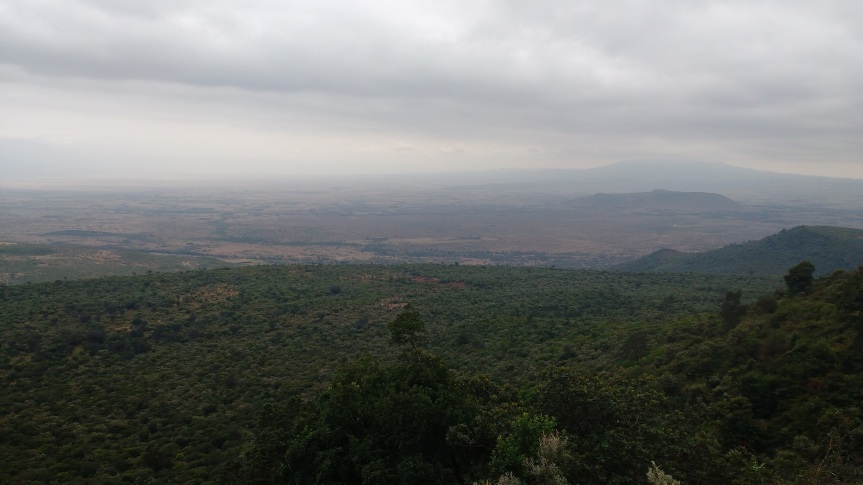
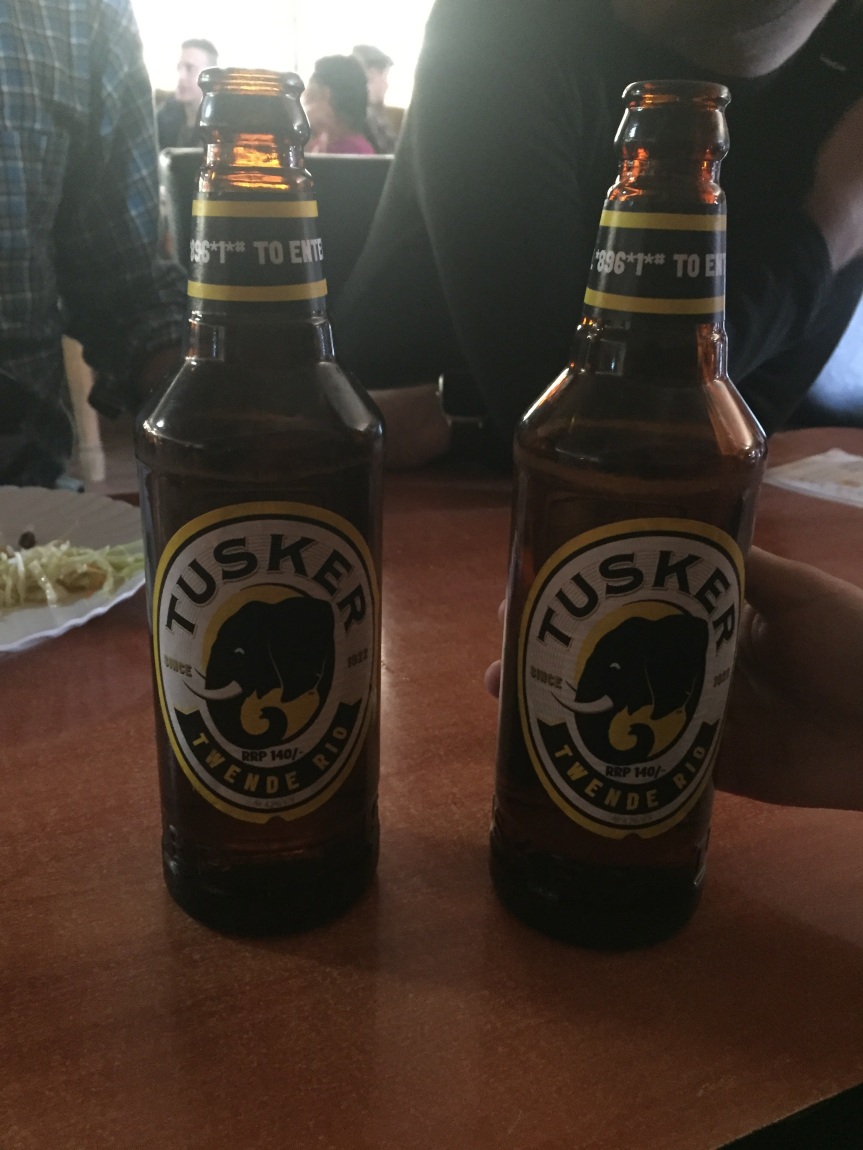
Arriving at the camp a little before 4 in the evening, we were welcomed by the manager and shown to our tent shacks. The Miti Mingi eco-lodge and a few others are located just outside the entry gate of the reserve. The camp is basic with limited electric supply. The common kitchen serves three meals a day in a buffet and any specials can be requested to the chef. The typical shack has 2 single beds with bedding and mosquito nets. The nets often have holes. Fortunately for us, there were few mosquitoes in August and the precautions we had taken were more than sufficient. The camp staff would also prepare a bonfire at night around which campers would sit to eat, drink and relax. Later that evening after our arrival at the camp, we took off for our first game drive a little past 5. At the reserve gate, local Masai women began to flock around the safari vans, trying to sell handicrafts and curios. The handicraft trade is an important source of income for the local communities. The same curios when bought in a retailer’s shop in the town can cost twice or even thrice as much. Naturally, the premium you pay in a shop is the retailer’s margin who buys the handicrafts at nominal prices from the original craftsmen. Hence, we decided to buy it from these women directly, both of us getting a better deal in that way.

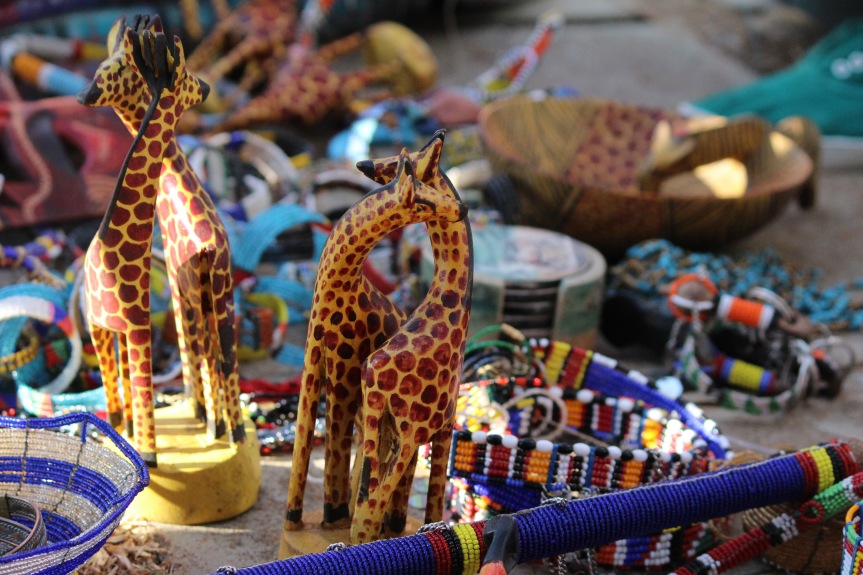
As we drove into the gate, we saw black spots strewn around the yellow brown grassland ahead of us. Moving a little further, the spots began to take shape and we could now make out their movements too. Tails wagging, horns locking, their grizzly goatee beards swaying, this was my first real sight of the much talked about Wilde beast. I’m positive I have seen more documentaries on this species of wild ungulates than any other. The great migration is a subject studied and researched by more wild life experts than any other possibly. As the day was drawing to a close, most of the beasts were resting or feeding callously. It was evident that there was no sign of immediate danger as the animals looked rather carefree. This meant that there were no big cats in the near premises. As we moved further inside, the African wild began to charm us in all its glory. A family of giraffes being led by the male head on our left, a solitary ostrich ducking and hopping in the grass to our right. A wild boar here, a gazelle there and a gang of baboons charging away. Our presence in their natural habitat was almost unnoticed as they went about their business without being bothered. The engine noise would occasionally startle a deer or two but in every other respect, Ambrose made sure that we were a part of the surroundings we were in and the animals were not disturbed. The setting sun cast interesting shadows through clouds on the grassland. One moment we would be under the sun and the next under a cloud’s shadow. The solitary van moving ahead of us against the infinite grassy slopes and the orange blue sky looked like a picture postcard come alive. The wind was in my face and it felt like I had time traveled into another world like an eccentric Dr. Who. From the sweltering humid honking of Delhi streets only a few hours ago to a boundless quiet in the cool wind of the African wild. If only this could be done anyday, anytime.
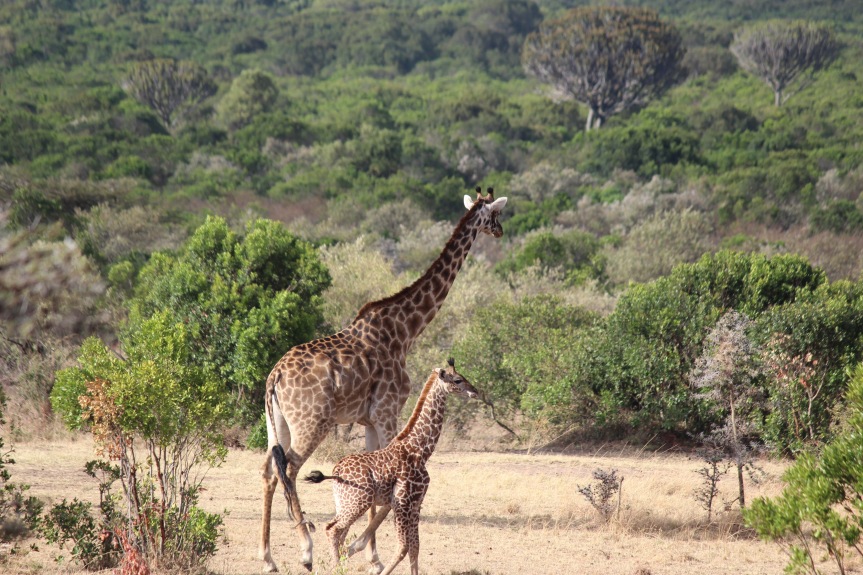
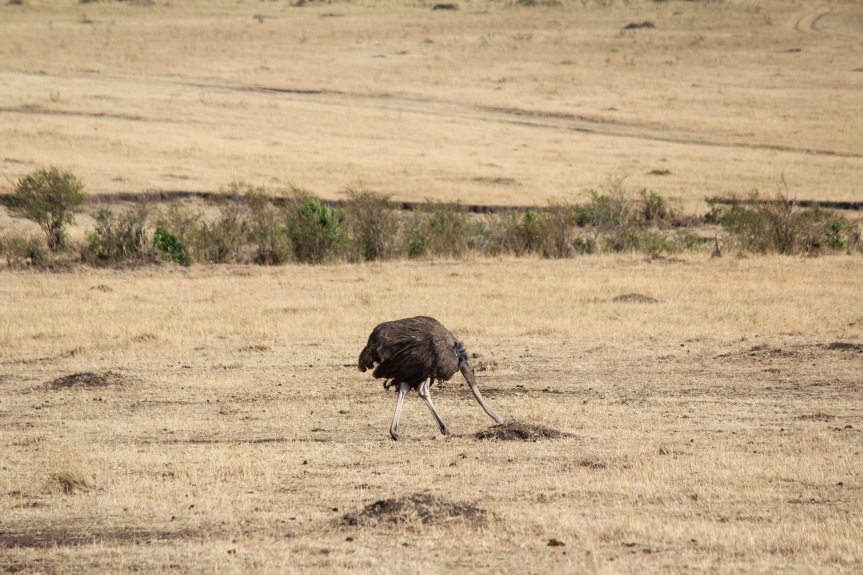
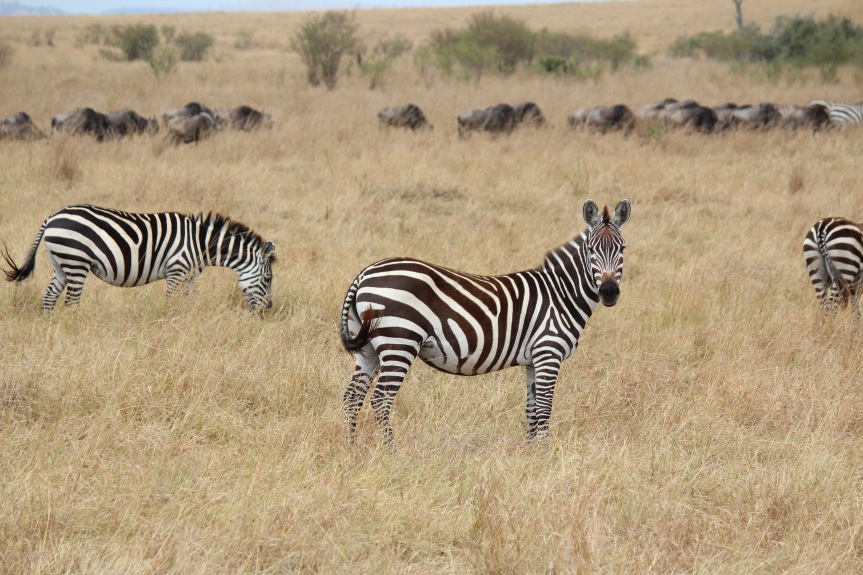
After about a half hour of off-roading, we stumbled upon a hillock and somewhere on our right, behind a bush, the American journo riding with us spotted the elusive rhinoceros. It seemed like he was trying to conceal himself, looking away, trying to tell us to go away. We waited for it to emerge out of the bush and just then it began to pour. The chances of getting a good shot of the bashful rhino were reduced by half but the idea of soaking in a bit of the African rain was welcomed by all. So we stood motionless with the hood of the van still open, waiting, getting wet and somewhat cold till the rhino emerged and when he did, we were all dumbfounded. To spot a rhino at close quarters in the Savannah is rare on account of the heavy poaching this poor species has suffered over the years. Today, it is an endangered species listed under IUCN red category. Ambrose did not fail to impress upon us that we were with the best guide in all of Mara.
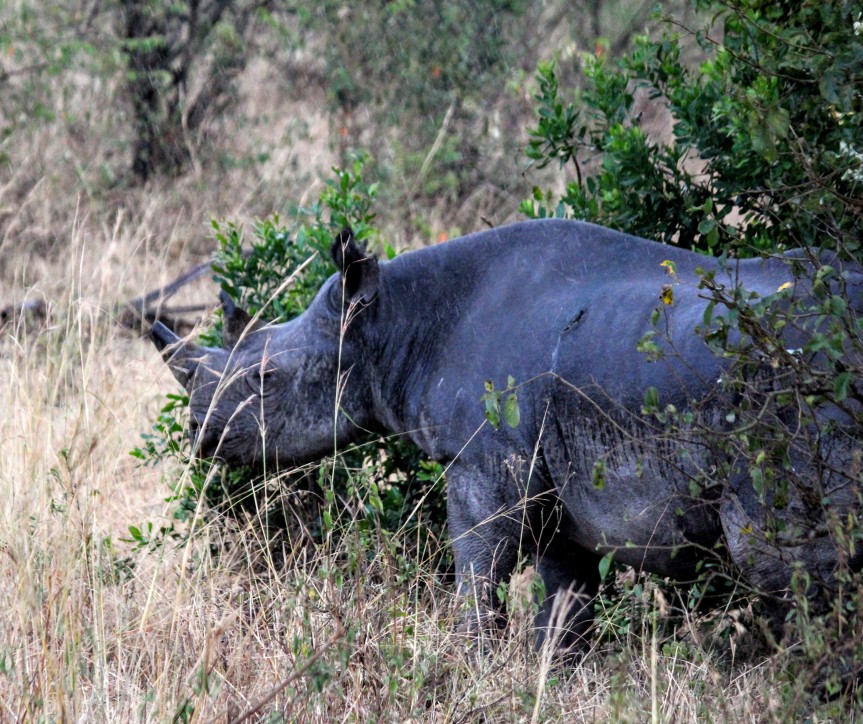
The rain got heavy and we had to shut the open roof of the caravan. As we turned around to go back the trail we had taken uphill, Ambrose got radioed of something exciting. After driving mad for a few minutes, we arrived at a clearing half the size of a football field. Far in the distance, near some trees, we were directed to look. With the help of our binoculars, we finally began to spot some movement and in no time were we sure of what we were looking at. To be able to see two of the Big African five on the very first day was no joke but to see them like we did, speechless. As they gradually began to emerge out of the bush and come closer to us, we were able to count not one, or two or three but at least six almost full grown young male lions. Boy, just to look at them gave me an unparalleled high. Here, I would like to mention that I have been to at least six different national parks all over India and never actually spotted a big cat in the open wild. I had seen many wild animals before but not a cat and to begin that streak with the African lion was nothing ordinary. The playful lions would go to their fresh kill from time to time to nibble on whatever was left of it. Clearly, one dead Wilde beast was not sufficient to satiate the hunger of six young lions. Soon enough, the sun began to go down and more and more caravans started pulling in. By now, almost all the safari drivers in the park that evening had been radioed in by their mates. One of the lions crossed the vans to go over to the other side of the clearing and took his seat atop a rock right next to us. To say that we were thrilled would be an understatement. A slew of selfies with the young male in the background followed, of course no flash photography was indulged in to avoid startling the animal, thus filling our phones with countless grainy images. As we stayed longer, a pattern began to emerge. Slowly, all the lions began to fix themselves in certain spots, a little away from each other, gazing incessantly in a singular direction. They weren’t in the least bothered by the large crowd of excited tourists but kept staring at a herd of Wilde beasts a little to our right. In our excitement of spotting so many lions on our very first game ride, we had failed to take notice of what was really happening around us. These young guys were going into an ambush to launch an attack on the closest herd of prey. The focus on their faces was something unseen before. I thought they were waiting for it to get dark enough so they could take advantage of their specialized night vision and catch the prey completely off-guard. Of course, staying till after dark is dangerous and against the rules of the park and when the drivers came to know of an approaching patrol van, they all began to disperse. We learned that the drivers are not supposed to off-road from the trail marked by the park administration but they do and therefore, the patrol vans can come in like flying squad from anywhere, anytime. As the night began to take over, we started moving back in the direction of the same gate we had entered through and soon enough we were back in the camp to stretch and rewind.
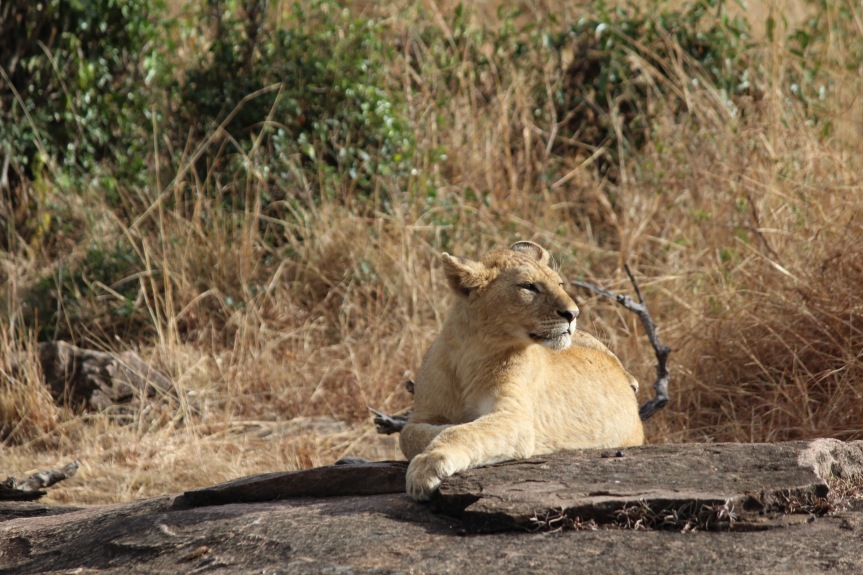
Like I had shared before, the camp in itself was very basic but the collection of so many interesting people around us made up for the lack of any indoor recreation. Our Masai guard cum handyman helped us build a bonfire in the open space outside the kitchen and gradually many campers began to gather around it. Americans, Canadians, Norwegians, Chileans, Sierra Leoneans , Somalians, Japanese, Chinese; journalists, World bank officials, students, teachers, photographers and boring jobs like us. I had never been in the same place with so many nationalities before and what is a better conversation piece in such a gathering than a racist joke that everybody finds funny. As the alcohol warmed our bellies and the fire, our exposed limbs, the laughter got infectious and before we knew there wasn’t one nationality around the bonfire that hadn’t been ambushed so to speak. From Chinese manufacturing to Indian head bobble, from Japanese expressions to Canadian Maple syrup, every known stereotype was indulged in. To be honest, that night I realized that us Indians are by far the most racist lot out there and didn’t quite feel proud of it. Few of our co-riders from the Safari were a team of young journalists covering the ongoing human crisis in South Sudan. A sudden surge in violence had forced them to take refuge in neighboring Kenya for a few days. They decided to make the most of it by going on the world famous safari in Masai Mara. The young Sierra Leonean Mustapha, who was one of them began to talk about his work and as he moved on from one crisis to another, poor Sonam began to well up and by the end of the conversation she was visibly upset. The rest of us decided to pick on our storyteller for making her cry and everybody had a good laugh. The night grew darker and the fire began to go out. We returned to our rooms drunk on aperitif and life stories.
The next morning, we set out as early as 7 following a filling but simple breakfast of Toast with butter, some beans, Mandazi, eggs and Coffee. As we arrived at the gate, once again we were welcomed by the Masai women selling curios. This time we bought a couple of bead necklaces and hand crafted miniature wooden animals. Being back in the park early in the morning gave us ample opportunity to see the landscape change its contours in the constantly increasing daylight. The morning was cold and the wind forced us to duck inside the caravan, rising up only when an animal came along. A whole day safari not only presents a plethora of opportunities to sight the many animal forms in the grassland but also brings with it some very real challenges like where to pee, what to eat, stretch your legs which are tired from hours of crouching among others. For us men, pissing in a field is as natural as it is for any wild animal, but the female tourists find it difficult given the terrain and the need for cover (modesty). Food is generally packed by your Safari operator and brought along. Caravans gather in a pre-decided spot where the tourists are allowed to come out and devour their packed lunches. We stopped on a hilltop overlooking the Savannah under the scorching noon sun for our picnic lunch after having spotted the third of the big five- the leopard. Technically, we saw two of them. The first was lying in a tree high up on a hillock, far from us and thus barely visible through binoculars. We were told by our guide that leopards evade tourists and are hard to spot. But a little later, we were called out to a bush where another leopard was busy nibbling on its kill without a care for all the caravans surrounding it and excited tourists stealing photographs. The animal seemed rather smallish from where we were and we assumed that it was a young solitary male.

Post lunch, we descended back into the valley below spotting many other animals, Cape buffalo among them, thus taking our Big Five count to 4. As the day drew closer, we advanced towards the river crossing over the Mara where the Wilde beast congregate to cross over. We were unaware of where we were going and as we approached nearer, a strange kind of excitement gripped Ambrose who started talking in an animated Swahili to his radio mates and began speeding away from all the caravans which had lined up along the bank. It appeared to us that he was following something but we weren’t sure what it was. As we got closer, we realized that we had been chasing a large herd on our side of the bank which was preparing to cross any minute now and just as we pulled over next to the last caravan, a stampede of its kind began to brew as Wilde beast one after another began climbing down into shallow river, passing right beside us. It was a mad crowd with a singular objective in mind. There must have been thousands of them as the crossing went over a good 5 minutes while we filmed. I cannot imagine getting caught up in that frenzy. This is a sight many come to Africa to behold- wildlife experts, photographers, film-makers and tourists. Without even expecting it, we had been blessed to see it right where it belongs, not on a TV screen or in a Nat Geo magazine, but in the heart of the East African grassland, the Masai Mara.


Almost as if the park knew what was missing from the most eventful day we could have, minutes later we were up, close and personal with a pride of full grown lions and lionesses, lazing under the bush, avoiding the 4 o clock sun. With a few great shots in our camera, we bid adieu to the king of the jungle and moved on for a rendezvous with a family of African elephants. As is the case, the female elephants (mothers) lead the clan and young ones follow. The family we met was busy playing with mud and water besides eating foliage. Few of the family almost exclusively posed for our camera before moving own. Having ticked the Big Five off our list besides a host of other animals exclusive to the African grassland, we concluded the longest safari yet, exhausted and content.

The next morning, after a final 2 hour game drive, we set out on the road to Naivasha, our next and final stop in Kenya. Somewhere midway, we bid adieu to Ambrose and hopped onto a different van which would take us further. We thanked our driver and guide with a barely opened bottle of French Aperitif and 2000 shilling, something I would call pretty generous by Indian standards but he expected more I thought. Anyhow, we were back on the road alongside a Spanish couple and another French-Polish couple onward to Naivasha. Once again, we were treated to the beautiful country landscape rising and falling from time to time, yellow green grass with lonesome trees in between.
Arriving in town a little after 4, we checked into Jane’s Guest house just outside the city centre. The swimming pool was clean and empty. We couldn’t resist ourselves and jumped in. After a lot of coaxing, Sonam finally agreed to slide down the little plastic ramp on the edge. Yunush, however, did not yield to any amount of persuasion. After the late afternoon dip, we decided to relax and unwind in the garden but as the sun went down it began to get cold pushing us back into the chalet. Next morning we started for the lake after breakfast, arriving at the shore around 10. Our guide and captain gave us life jackets and a few instructions and we were good to go. The sun was out and the soft warmth of the sun-rays made the cold morning comfortable and enjoyable. We pulled out our binoculars as the guide began pointing in different directions. Lake Naivasha has rich bird life as well as some wildlife along the shores and underneath. We spotted hippos who as expected were almost entirely under water at this time of the day. Their sensitive skin doesn’t take too kindly to the equatorial sun and they spend most of their daylight hours under water emerging only after dark to graze. They can be aggressive and should be avoided at any time. We observed from a safe distance as two of them began to hump. This particularly is a very sensitive time when you wouldn’t want to disturb them so we moved on. Over the next one and half hour we spotted several birds such as pelicans, cormorants, herons, ibises and storks. But the showstopper was the Fish eagle without doubt. When our guide first tossed the fish in his hand into the air, the eagle sitting on the far edge of the tree did not seem to bother. She is nesting, he explained. After two more failed attempts and his repeated mimic calls there was no sign of the eagle emerging out of the trees to fetch the little catch. But as every show must end with a grand finale, the fourth time our captain threw the now very dead fish into the air, a gliding eagle descended from the tree tops to pick up the catch which had barely landed on the water and even before one of us could capture it on film, flew away into the tree tops again. Content with everything we had been able to see and absorb in our 90 minute boat ride, we returned to the shore. Thanking our captain, we started once again, this time for our very last destination- Hell’s Gate.
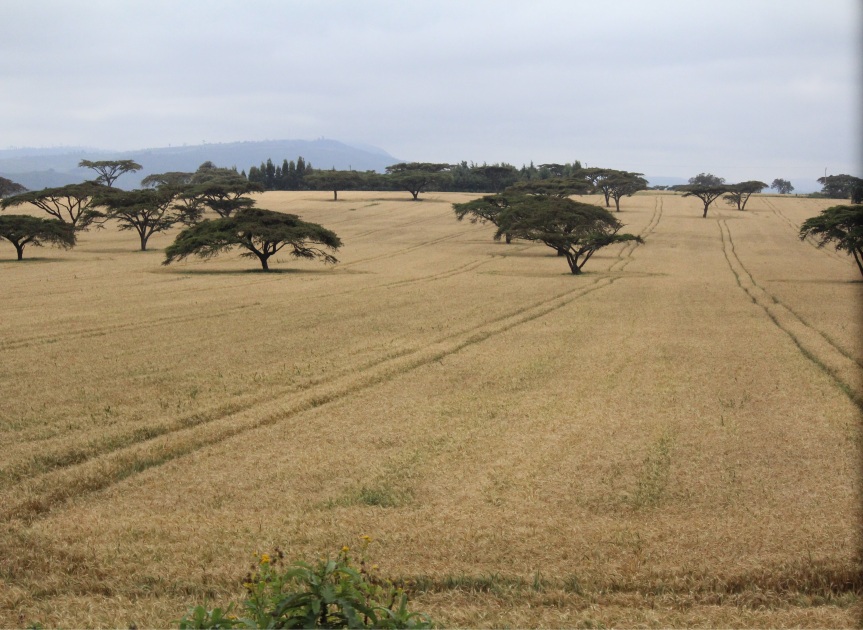
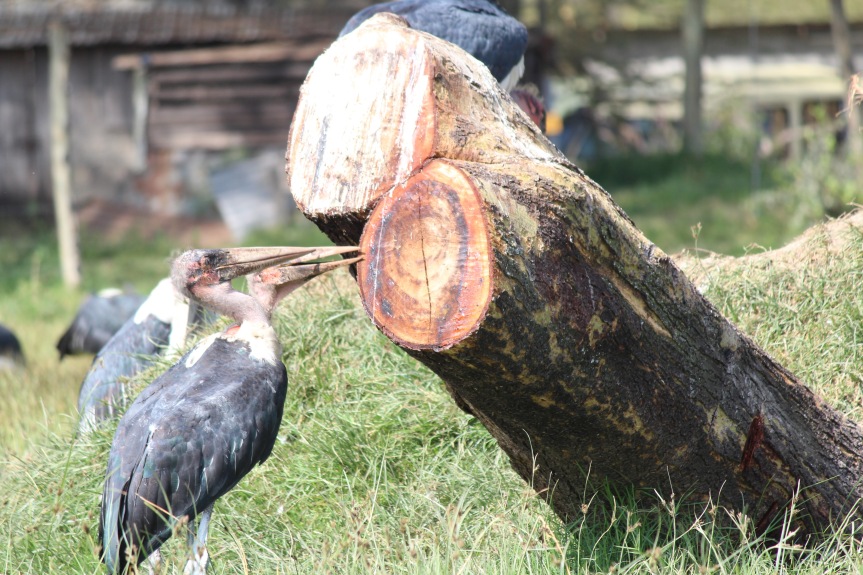
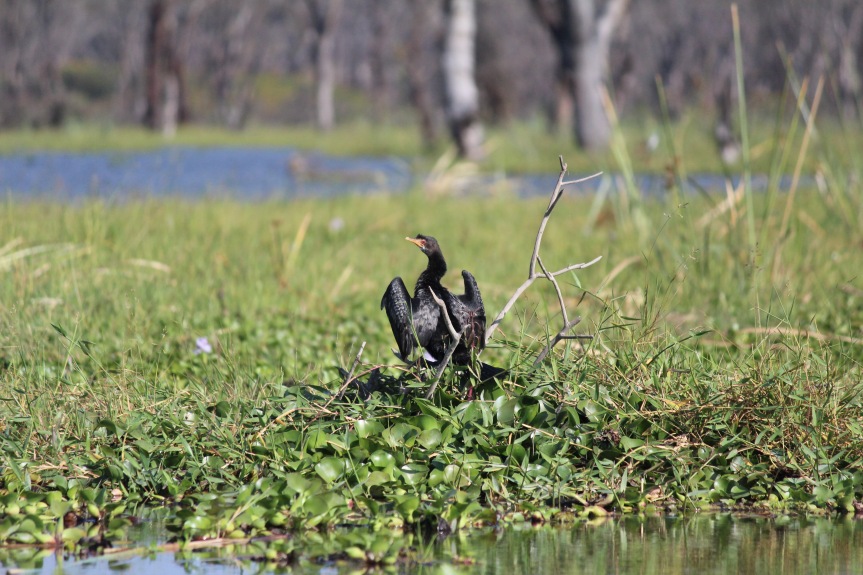


Hell’s Gate National park has earned its name from the dramatic rock formations that mark the entrance of the park, the most popular being Fischer’s tower. Geologists till date have not been able to find a satisfying explanation for the appearance of these strange other worldly structures. Being here is like being on the sets of a Hollywood adventure movie shot in some unreal world. The weather was nice on our last day of adventure in Africa. We rented these half broken bikes at the Elsa gate where we were dropped off by our driver. There are no other options available. If you want better bikes, bring your own. Having come unprepared, we were forced to carry our picnic lunch and water supply in plastic bags on the handlebars of our bikes which obviously was as uncomfortable as it could get on that terrain. All along, there is a dirt road that runs through the park for some 8-10 Km before merging with the asphalt road ahead going to the Olkaria geo-thermal power station. As we rode along this path, sometimes off-roading to get a closer look, we saw grazers like the Zebras, hog-warts, deer and baboons. We also saw the shadows moving clouds formed between the cliffs on both our sides. As the sun came up in the equatorial sky, the sweat came out and riding became more difficult. Sonam, in spite of her weak legs, pedaled through it all till the picnic point above the gorge. Here we sat down to eat our packed lunch alongside opportunistic monkeys and baboons, looking sideways as we quickly gobbled down our sandwiches, protecting them from the ever hungry primates. The road further was all uphill and riding up seemed more than what we could take. With the Olkaria spa in mind we decided to give it a try only to realize within the first 10 minutes that we wouldn’t make it. I was heartbroken to say the least. The possibility of soaking my sore body in warm therapeutic waters of the bath was slowly dying in front of me. With much grief, we called off the plan to continue further and decided to return to Elsa gate, the point where we had started. The ride back was that much more tiring and took its toll on us. We dropped off the bikes at the gate and continued walking back to the main road which is almost a kilometre further. On the main road, we hopped onto the famous city matatu and rode back into town.
The last dinner in Kenya was a special prepared by the home-chef at Jane’s. We were exhausted and hungry. Fortunately, we had the whole kitchen to ourselves and the food was pretty good. It tasted homely and that lifted our spirits a little. As every year it was time for Sonam’s birthday cake which I had ordered from a local baker. As I had ordered pretty late, there wasn’t much choice left and I had to settle for blackforest pastries instead of a red velvet which was my first choice. Poor Sonam, after the most tiring birthday ever, seemed happy to have a cake at least. In that moment I felt so proud of her. She had gone through the whole day with the rest of us just to be with me, to not miss a single moment of us.
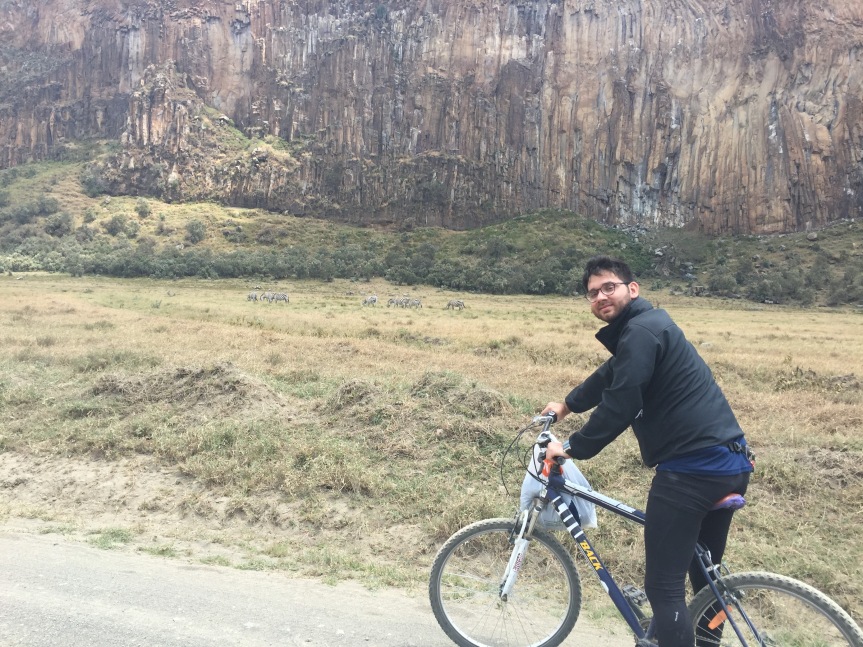
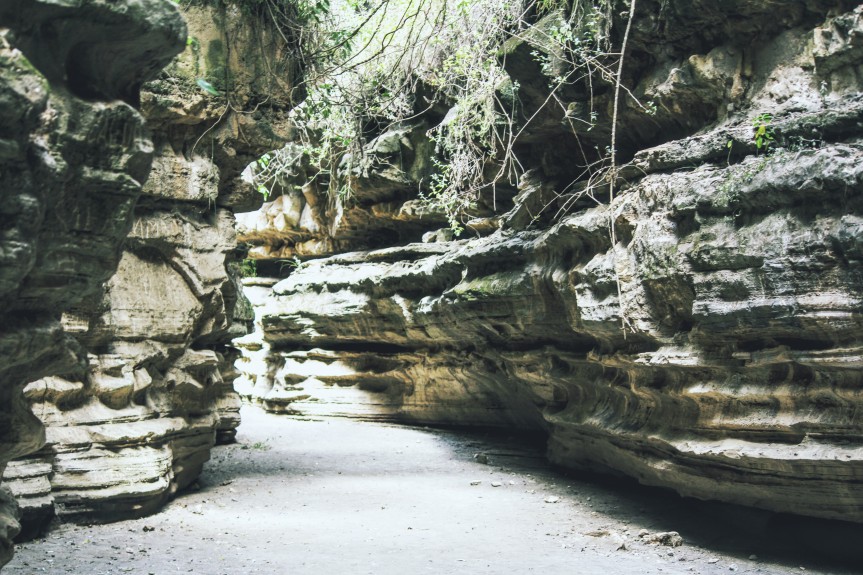
Next morning, we started back for Nairobi International Airport. Since, we had some extra time, we decided to stop by the famous Masai market on Kijabe street near the Globe flyover. After much haggling, we managed to pick up a few curios- fridge magnets, ornaments, miniature wooden tribesmen and a safari hat. At the international terminal, our African sojourn came to an end with all of us carrying many memories and images of the African wild and the people back home with us. I am positive that anyone who ever took this journey would find himself richer with a very unique experience. An experience which is overwhelming and humbling at the same time. There are many other corners of the African continent which are worth visiting and I’m confident this was just the beginning for us.
So long Africa!

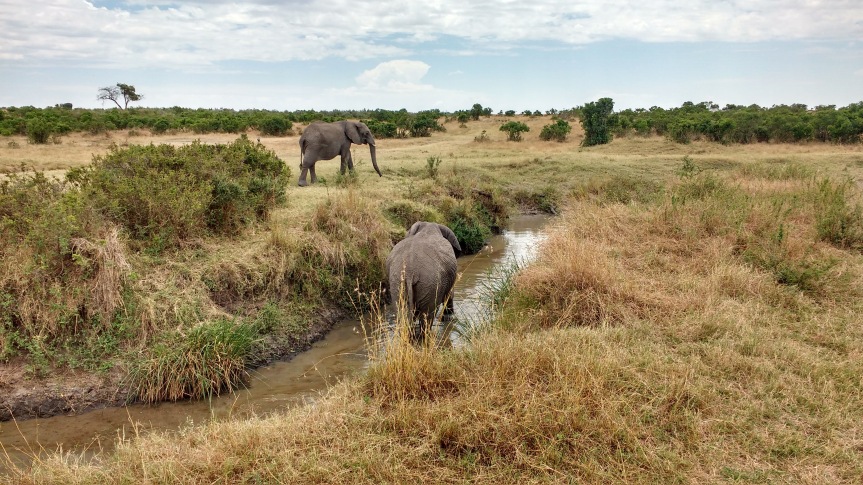
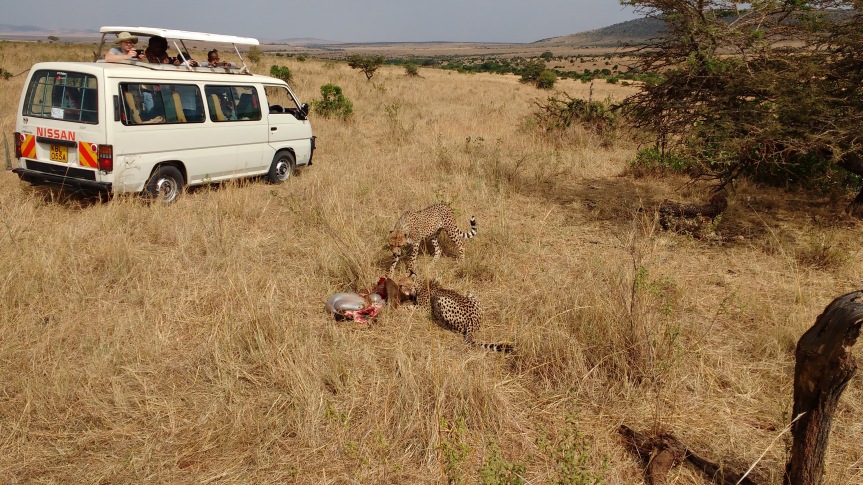
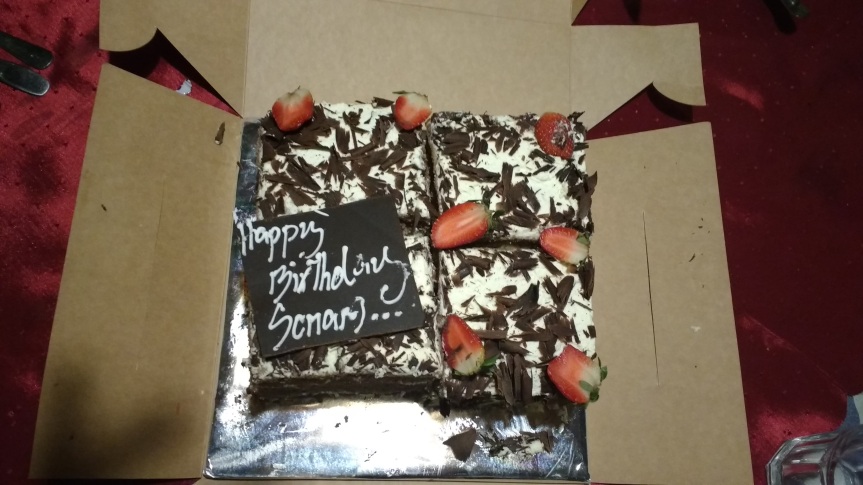
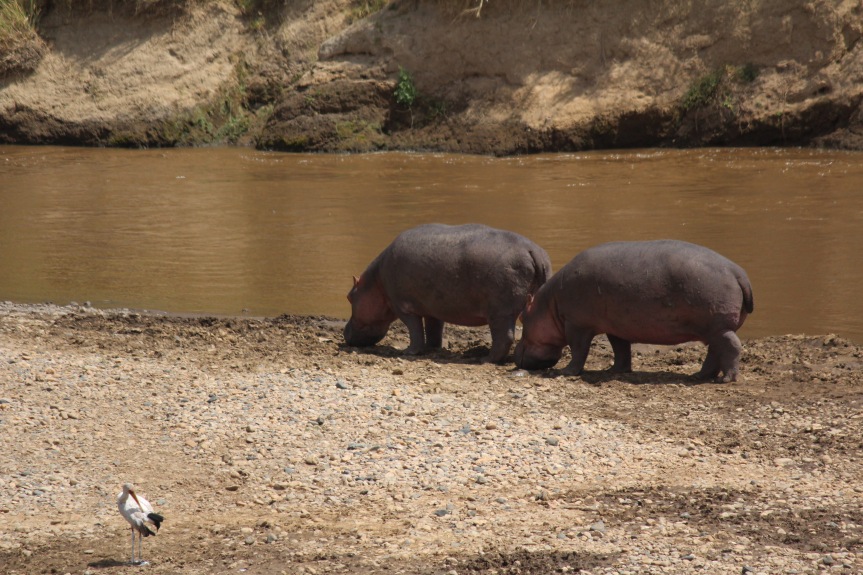

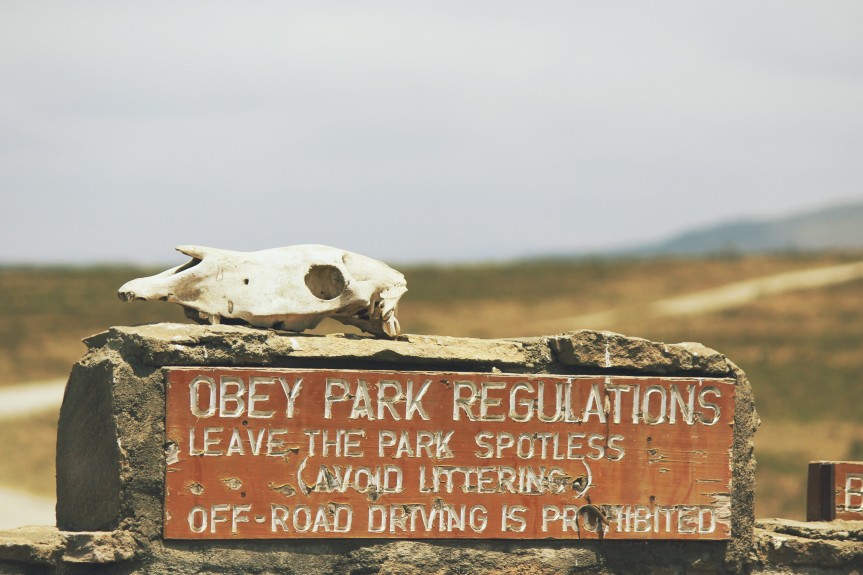
Photo courtesy: Prince Arora and self

